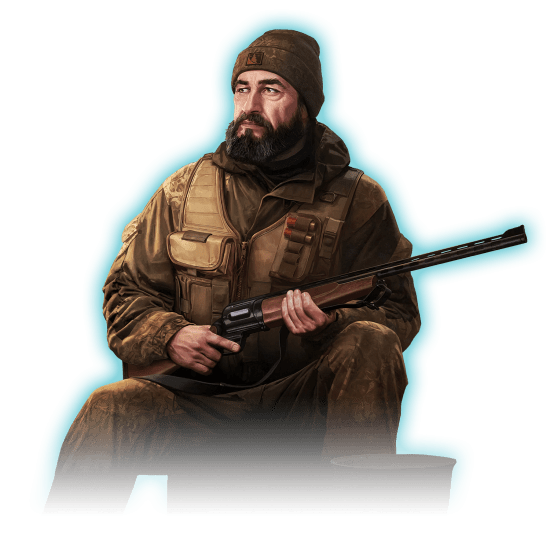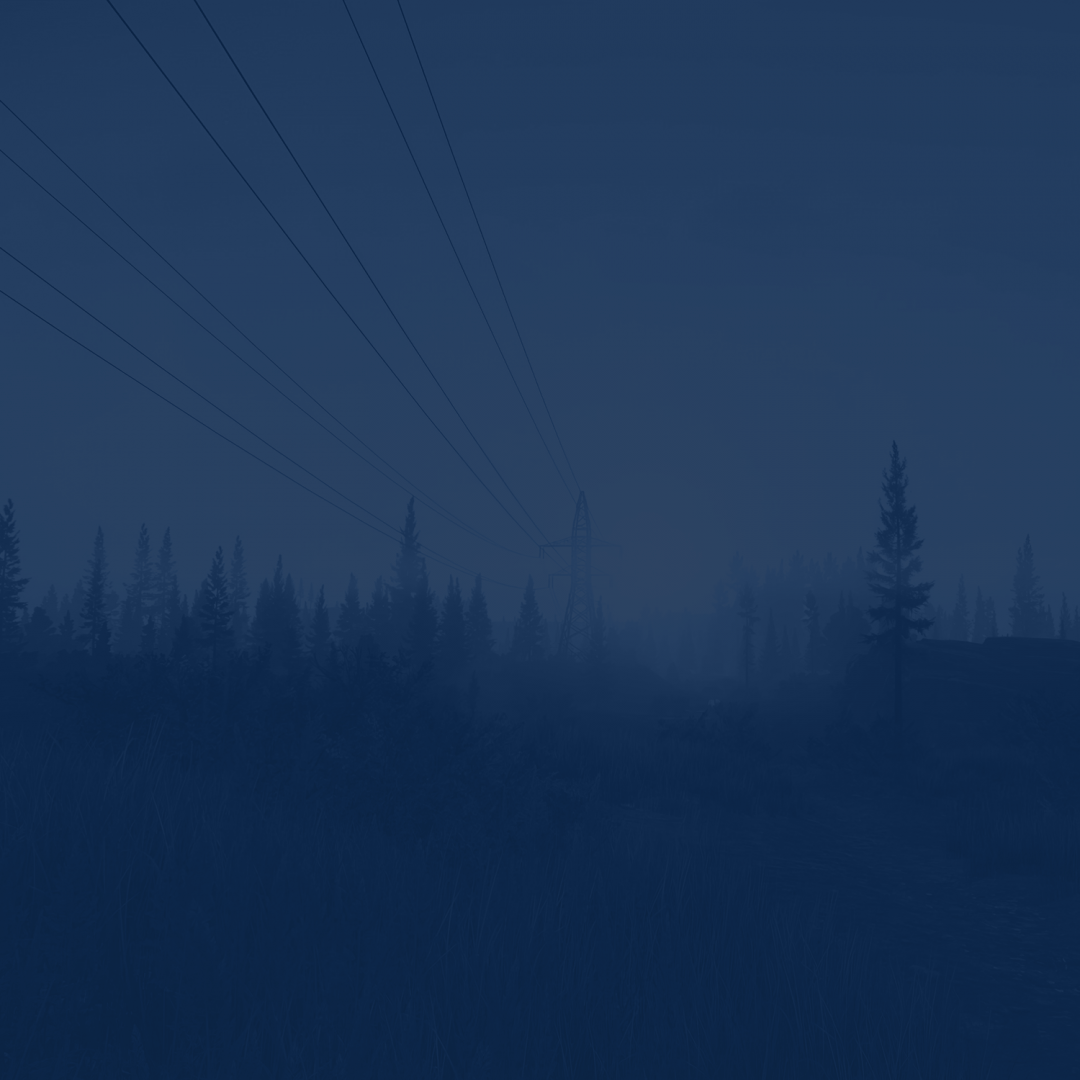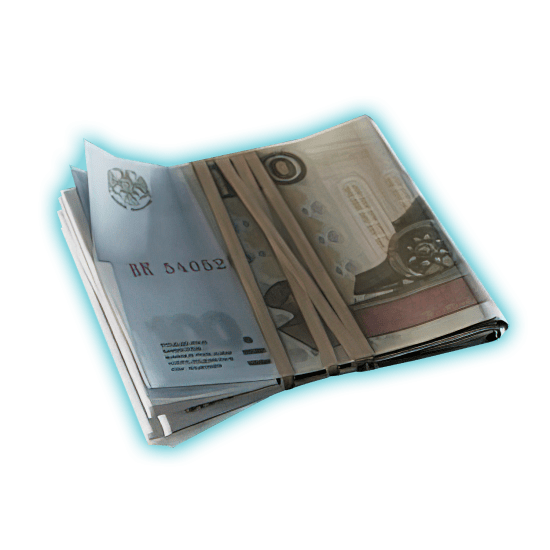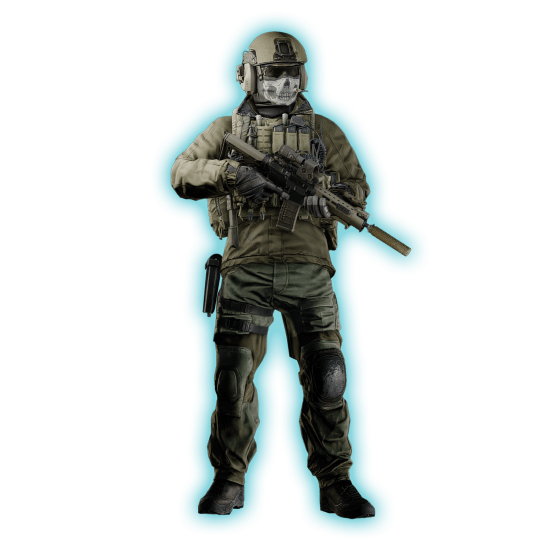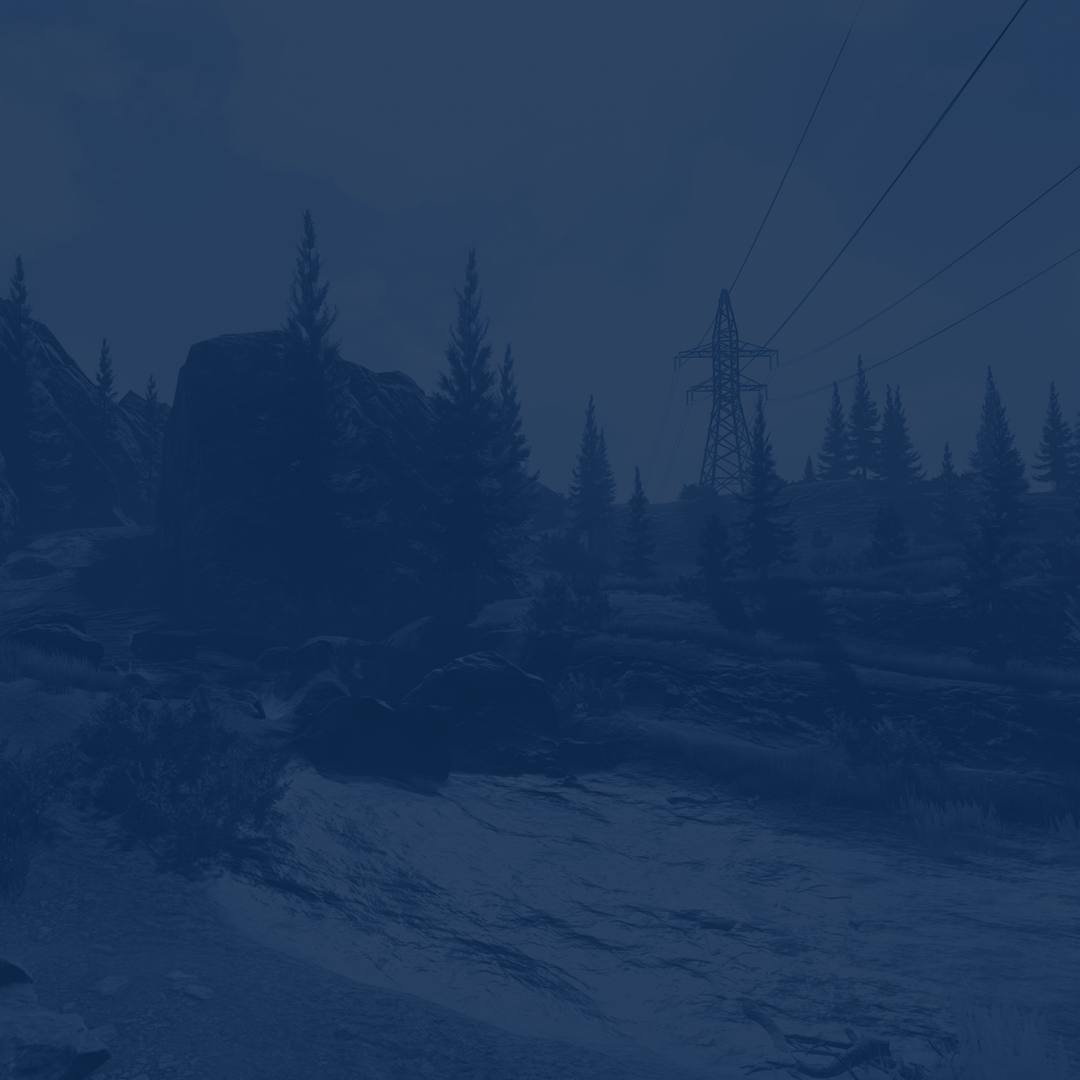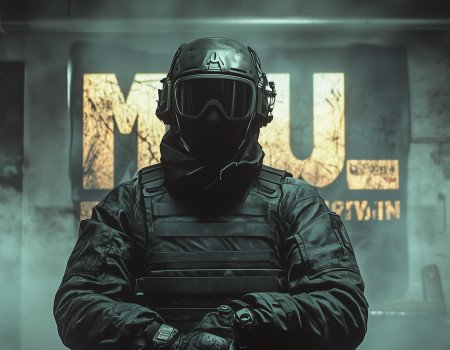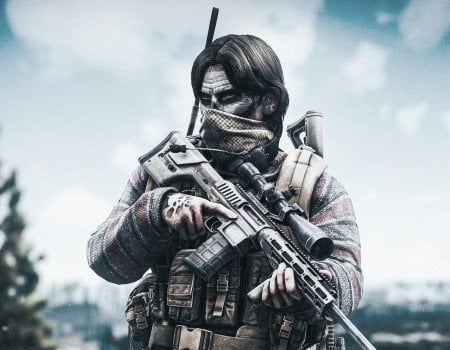Quests in Escape from Tarkov are the real roadmap to progression — not just side content. In this Escape from Tarkov quest guide, we’ll explain how quests work. We’ll cover things like NPC traders who offer quests, quest types, requirements, rewards, and, more importantly, some good tips for completing your quests as quickly as possible.
If you need extra help questing, you can get one of the services at Skycoach, like the Tarkov Jaeger quests boost, which will help you complete any or all quests for this trader. Similar services are available for all trader quests, and there are even dedicated quest services. Regardless of your choice, Skycoach services are provided by professional Escape From Tarkov players, the true veterans and SHERPas of the game. So, if you struggle to complete some quests, save yourself time and headaches and let Skycoach’s pros help you out!
Read our other EFT guides:
Note: At Skycoach, you can Buy Escape from Tarkov Boost at the best prices with fast delivery. Use our special PROMO CODE (in green) hidden in this article for a 20% DISCOUNT.
What Are Quests in Escape From Tarkov?
Quests in Escape From Tarkov are more than just side activities — they’re the backbone of your long-term progression. Unlike traditional shooters, where quests might feel optional or repetitive, EFT quest system is intricately tied to your character’s development, access to resources, and even the unfolding lore of the game. Every task you accept from a trader pushes you deeper into the world of Tarkov, both narratively and mechanically.
At their core, quests serve a few key purposes:
- PMC progression: Quests are the most reliable way to gain experience and level up your PMC.
- Trader access and loyalty: Completing tasks boosts your standing with traders, unlocking better gear, ammo, and items for purchase.
- Unlocking in-game systems: Some quests unlock critical features like hideout upgrades or access to other traders (e.g., unlocking Jaeger).
- Narrative immersion: The questlines aren’t just checklists—they reveal the backstories of the traders and the power dynamics at play in Tarkov.
If I wanted to have Tarkov quests explained, I would have to repeat myself, and say that quests are connected to every other aspect of the game, be it progression, economy, crafting, etc.
Early in a wipe, everyone starts with the same (more or less) basic gear, the same level-1 traders, and limited access to the flea market. To get ahead, you have to start knocking out quests. The first few — like Prapor’s “Debut” or Therapist’s “Shortage” — are designed to get you exploring basic maps like Epicenter and Customs, while teaching you how to extract with items or take down Scavs. But soon after, the difficulty ramps up. You’ll need to find rare items, survive tricky extracts, and even make moral decisions between traders.
Some quests have "Found in Raid" (FIR) requirements, which means you need to find the item during a raid and extract it alive with it. That system alone makes quests a lot more intense, since you can’t just buy everything off the flea market and be done with it. You have to earn it.
Here’s a quick comparison of early-, mid-, and late-game quest roles:
| Stage | Quest Focus | Rewards | Impact |
| Early Wipe | Intro to maps, basic kills, first extractions | Small EXP, Rubles, starter gear | Unlock new quests, gain rep |
| Mid-Wipe | More kills, rare items (FIR), exploration | Higher EXP, keys, better gear | Unlock better trader stock |
| Late-Wipe | Complex chains, PvP challenges, rare item turn-ins | Unique gear, THICC cases, Kappa progression | Full PMC power & status |
However, even some of the first Prapor quests will have you locate a key, find what door that key opens, and, with very little description of what to look for, you have to find the requested item and extract it with it. How’s that for starter quests? Furthermore, the so-called “newbie” map Epicenter is not exactly new player friendly, mostly because of its small size and only a handful of points of interest that every player rushes to, because they have quests there. All of this forces you to go head to head with other players, sometimes in the first minute of you being spawned into a raid! New player map my ass!
Are Quests Optional?
Technically? Yes. But if you're not questing, you're falling behind.
Not doing quests means:
- You won’t level up fast enough to unlock the flea market (Level 15).
- You’ll miss out on some of the most powerful gear and ammo in the game (e.g., Level 3 Peacekeeper stock).
- You won’t gain enough reputation with traders to unlock their higher tiers, meaning you’re stuck buying trash-tier gear.
- You’ll be missing entire pieces of the game’s storyline and lore.
So while you can just go in and PvP your way through raids, most players treat quests as their main goal in Tarkov — especially early on.
Not All Quests Are Created Equal
Tarkov’s quests vary wildly in terms of difficulty and value. Some are straightforward — kill 5 Scavs on Customs and you’re done. Others are multi-step slogs that require expensive keys, multiple map runs, and surviving high-traffic PvP zones. And then there are the “dreaded” quests that even veterans groan about, like “The Guide” (survive 7 maps in a row without dying) or “Postman Pat” (a dead-letter run with a surprisingly high failure rate).
You’ll also run into:
- Time-limited quests (e.g., daily or weekly quests from Fence)
- Faction-based quest decisions (choosing between Skier or Therapist)
- Hidden or chained quests that unlock only after completing others
The result? A quest system that feels alive. Every task you take on influences the world around you and the path your PMC takes through the game.
Who Gives You Quests in Tarkov?
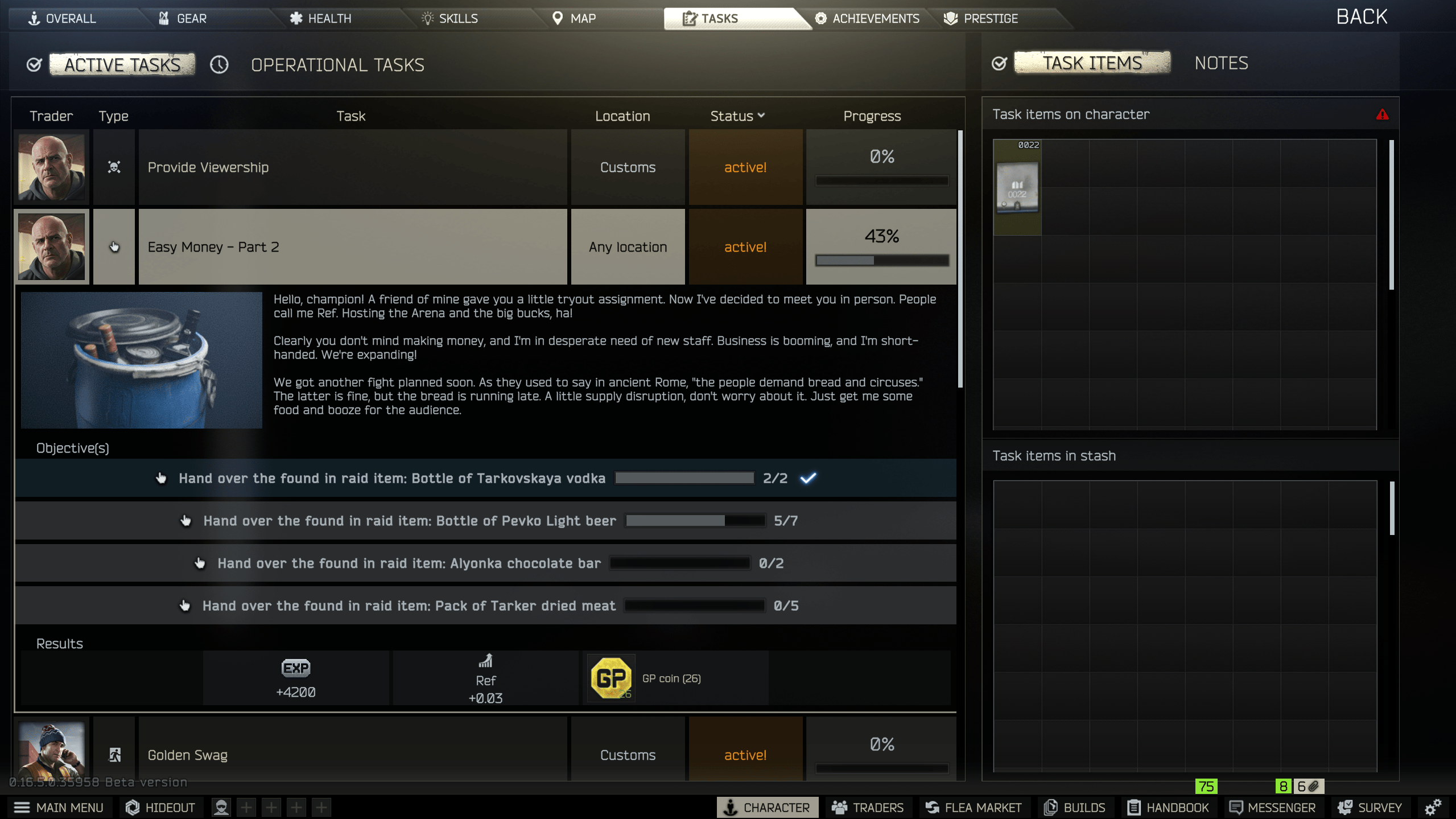
In Escape from Tarkov, your primary source of quests is the traders — a mix of arms dealers, medics, smugglers, and other shady figures trying to survive or profit in the chaos of Norvinsk. As of 2025, the game has expanded beyond the original set of traders, introducing characters with specialized questlines, inter-game connections, and unique services that go far beyond “kill 10 scavs.” Now, it’s up to you to find the best quests in Escape from Tarkov, but the best way to do it is, of course, by their risk/reward ratio.
Let’s break down all quest-giving characters in Tarkov — including the new additions like Ref, Lightkeeper, and the BTR Driver — and what makes each of them important.
Main Traders (Classic PMC Progression Path)
These are the original set of traders. You’ll interact with them from your very first raid until your last run for the Kappa container.
| Trader | Focus | Typical Quest Types | Notable Unlocks |
| Prapor | Military weapons & ammo | Elimination, item delivery, raid navigation | Early armor & ammo; weapon mods |
| Therapist | Medical & barter items | FIR fetch quests, survival, navigation | Meds, containers, hideout parts |
| Skier | Mods and tactical gear | PvP-heavy, morally questionable tasks | Unlocks Peacekeeper |
| Peacekeeper | NATO weapons & ammo | Currency-based tasks, Shoreline runs | US ammo, late-game armor |
| Mechanic | Gunsmithing & tech | Weapon builds, barter chains | Gunsmith series, crafting parts |
| Ragman | Apparel & rigs | Clothing unlocks, barter gear quests | Large rigs, high-end armor |
| Jaeger | Survivalist hunter | Harsh FIR tasks, long-distance kills | Early barter trades, hideout gear |
| Fence | Scav karma & daily system | Scav tasks, daily/weekly missions | Fence rep for car extracts, rewards |
Each of these traders has an Escape from Tarkov progression tree that builds your PMC from weakling to war machine. But they’re no longer the only quest sources. BLOG20
Ref – The Arena Crossover Contact
Ref is a special NPC that connects Escape from Tarkov with its spin-off game, EFT Arena. He acts as both a bridge and a rewards handler between the two titles, allowing progression to influence your main character across both games.
- How to unlock: Complete “Easy Money - Part 1” from Skier
- Focus: Cross-mode quests, Arena challenges, item transfers
- Unique Feature: Lets you send items found in Arena matches back to Tarkov
- Strategic Value: Ref is your go-to for Arena players who still want to benefit their PMC and get access to rare loot outside of traditional raids.
Quests from Ref usually revolve around achieving performance goals in Arena matches or gathering intelligence for use in the main Tarkov storyline.
Lightkeeper – The In-Raid Trader
Lightkeeper is Tarkov’s most secretive trader — and the first one to exist entirely in-raid. You won’t find him in the trader menu. Instead, he resides on the Lighthouse peninsula, guarded by Zryachiy and an army of Claymores.
- Location: 3rd floor of the Lighthouse, must deactivate traps using a secure DSP radio transmitter
- How to unlock: Begin with the questline “Network Provider - Part 1”
- Quest Themes: Espionage, high-level diplomacy, cult interference
Notable Services:
- Sacred Amulet: Prevents Cultists from attacking you for 7 raids
- Rogue Support: Rogues ally with you and fight on your side
- Zryachiy Support: Zryachiy becomes an ally and provides suppressive fire
Lightkeeper’s quests are high-stakes, high-reward. They're generally accessible in the mid-to-late game due to the complexity of reaching him and the requirements to even begin dialogue. His offerings can significantly shift raid dynamics if used wisely.
BTR Driver – Your Mobile Extraction & Support Contractor
The BTR Driver is a semi-nomadic NPC who offers quests and services related to mobility, item transport, and tactical support across Woods, Streets of Tarkov, Lighthouse, and other maps.
- Core Service: Drives a BTR vehicle that can transport you to key locations during a raid (for a fee)
- Extra Perk: Can deliver items to your raid mid-match, though with a time delay
- Quest Focus: Map exploration, PvE kills, item stashing, multi-map objectives
- Reputation System: Has his own rep level, unlocking future transport and barters
Example BTR Quests:
- “Shipping Delay – Part 2”: Scout warehouse locations across Woods
- “Swift Retribution”: Eliminate Scavs while learning BTR routes
- “Battery Change”: Trade in a military battery for a major EXP payout
- “The Price of Independence”: Multi-map saga involving stashing documents, using transits, and eliminating targets.
This trader adds in-raid logistics and mobility to your strategy, and is especially valuable for players who want more tactical options beyond running on foot and hoping for the best.
Why These NPCs Matter Now
Tarkov’s trader system has evolved into something that rewards exploration, risk, and knowledge — not just grind. These new quest-givers:
- Add more vertical depth to your quest options
- Provide mobility, tactical advantage, or cross-game benefits
- Reward players who take the time to unlock hidden content and build rep beyond just PMC level
If you’re ignoring Ref, Lightkeeper, or the BTR Driver, you’re not playing modern Tarkov — you’re playing a 2020 version of it.
Quest Types, Requirements, and Items in Tarkov
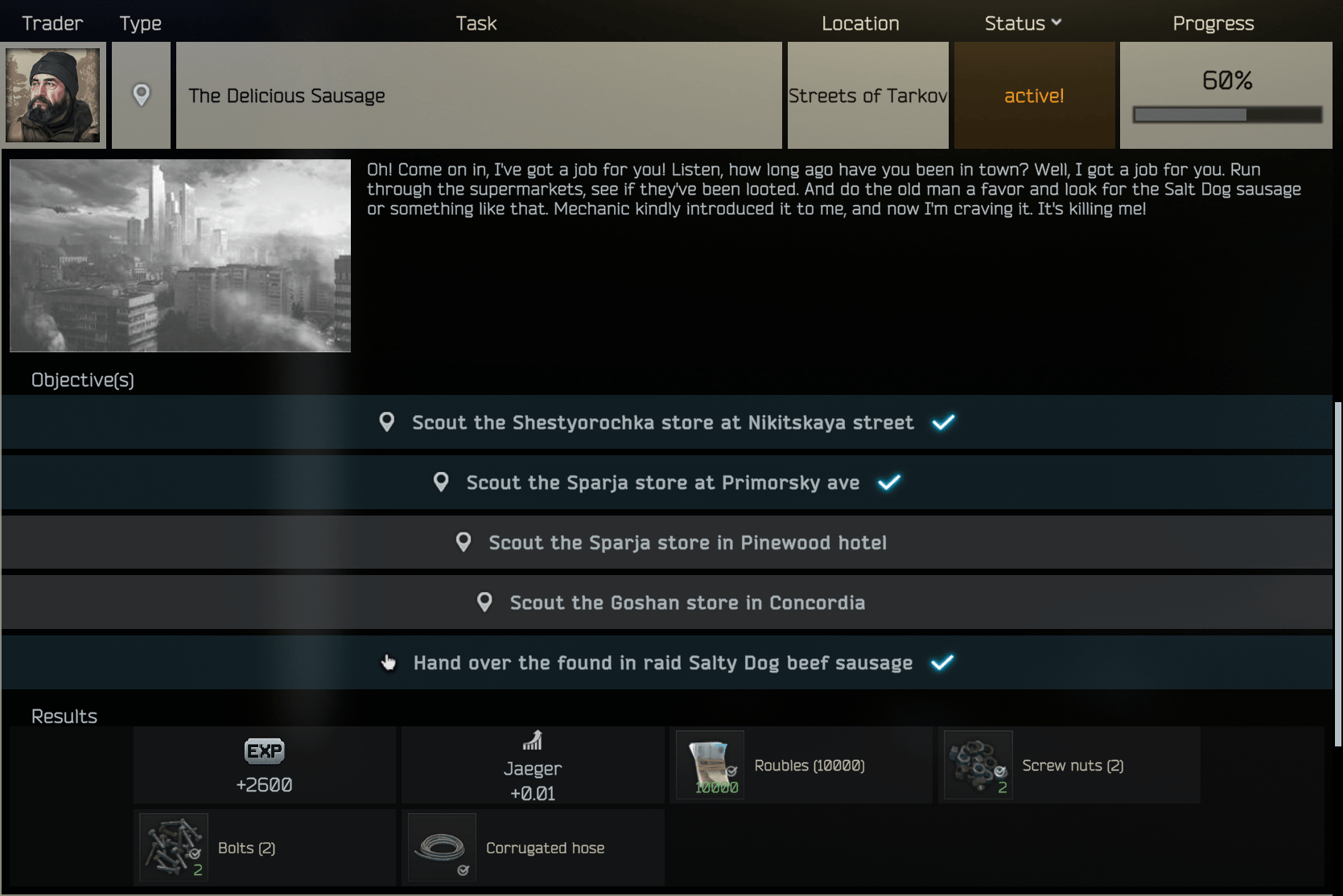
Tarkov’s quests might all come from familiar faces, but they vary wildly in structure, complexity, and failure risk. Some are as simple as “kill 5 scavs,” while others turn into multi-raid sagas that require rare items, timed objectives, or surviving PvP hotspots with fragile loot in your gamma.
Understanding the types of quests, their core mechanics, and how Found in Raid (FIR) rules work is essential if you want to quest efficiently — or even survive them at all.
The Core Quest Types (and How They Evolve)
Most quests fall into a few general categories. Early quests tend to stick to one type, but later ones will combine objectives (e.g., kill X enemies while marking a spot and surviving a specific extract). Here’s how they break down:
| Quest Type | Description | Common Examples |
| Elimination | Kill a specific type of enemy (Scavs, Raiders, PMCs) on specific maps, often with specific weapons | Prapor’s “Debut”, Skier’s “The Punisher” series |
| Item Turn-in | Find and deliver a specific item, usually with FIR status | Therapist’s “Shortage”, Mechanic’s “Farming” |
| Mark & Recon |
Locate areas and use MS2000 markers to flag them |
Ragman’s “Database”, BTR Driver’s “Ask for Directions” |
| Extraction-Based | Survive raids after visiting certain locations or completing objectives | “The Guide”, “Anesthesia” |
| Craft/Build | Assemble specific weapon builds, often in a hideout or from Gunsmith quests | Mechanic’s “Gunsmith Part X” |
| Stash Quests | Hide items at specific spots during a raid (often high risk) | “Humanitarian Supplies”, “Discombobulate” |
| Chain/Storyline | Multi-part quests with escalating objectives, sometimes influencing other traders | “Friend from the West”, “Easy Money” |
So, not only do quests range in complexity, but they also are like mini-stories. They’re never just a list of things to-d,o and if you are really into the lore, reading them can be worth your while.
Found in Raid (FIR) — The Rule That Changes Everything
If you’ve ever rage-quit after finding a quest item only to realize you can’t turn it in — you’ve probably run into the FIR (Found in Raid) system. This is the mechanic that separates Tarkov from other games and directly affects how you play quests.

FIR Requirements Mean:
- The item must be looted during a raid and extracted while alive
- Buying it from the flea market doesn’t count
- Crafting in the hideout ALWAYS counts as FIR (check patch notes for possible exceptions)
- Insurance returns or items looted from dead friends don’t count
This mechanic is in place to stop players from buying their way through quests and to encourage real in-raid risk. It also creates some of the game’s most tense moments — like surviving Customs with a Gas Analyzer in your Alpha container.
Here’s a short list of commonly needed FIR items that you should never sell early in a wipe:
| Item | Used In Quests | Maps to Farm |
| Gas Analyzer | Therapist’s “Sanitary Standards” | Interchange, Reserve tech stores |
| Flash Drives | Skier’s “Golden Swag”, Mechanic’s “Signal” | Interchange (tech shelves), Woods (camps) |
| Secure Flash Drives | Mechanic’s “Signal - Part 4” | Interchange, Streets of Tarkov |
| USB Adapters / Wires | Hideout + Quests | Scav loot, industrial zones |
| Car Batteries | Mechanic’s “Farming” series | Customs garages, Interchange parking |
| Military Cables / Corrugated Hose | Hideout + late quests | Reserve, Streets of Tarkov |
Pro tip: Always check Tarkov.dev or Tarkov Wiki to see if an item is required for a quest later before dumping it on the flea for quick rubles.
Quest Bottlenecks and Progression Gaps
Some quests stop players in their tracks because of:
- Rare item spawns (e.g., flash drives, RFID readers)
- Skill requirements (some require a minimum Strength or Endurance level)
- Map access or knowledge (e.g., “Living High is Not a Crime” on Streets)
- PvP-heavy objectives (killing PMCs on specific maps with specific guns)
- Multistage chains where failing one step resets progress
You can think of the early game as linear, but mid-to-late game quests form a kind of open-world tangle. You’ll often be juggling:
- 6–8 active quests
- Across 4+ maps
With competing item needs (e.g., you need 3 flash drives, but one is FIR and one’s for the hideout)
High-Risk, High-Reward Item Quests
Some quests ask you to:
- Stash rare items during a live raid
- Deliver items across maps using transit systems (via BTR)
- Wear specific gear (like a USEC outfit) during PvP missions
- Kill players with exact weapon builds (e.g., 12-gauge shotguns with no suppressor)
These quests are designed to force creative loadouts, increase raid variety, and generate PvP hotspots. If you're struggling, team up or run at off-hours to lower risk.
Quest Rewards: EXP, Trader Rep, Gear, Unlocks & Why Questing Matters
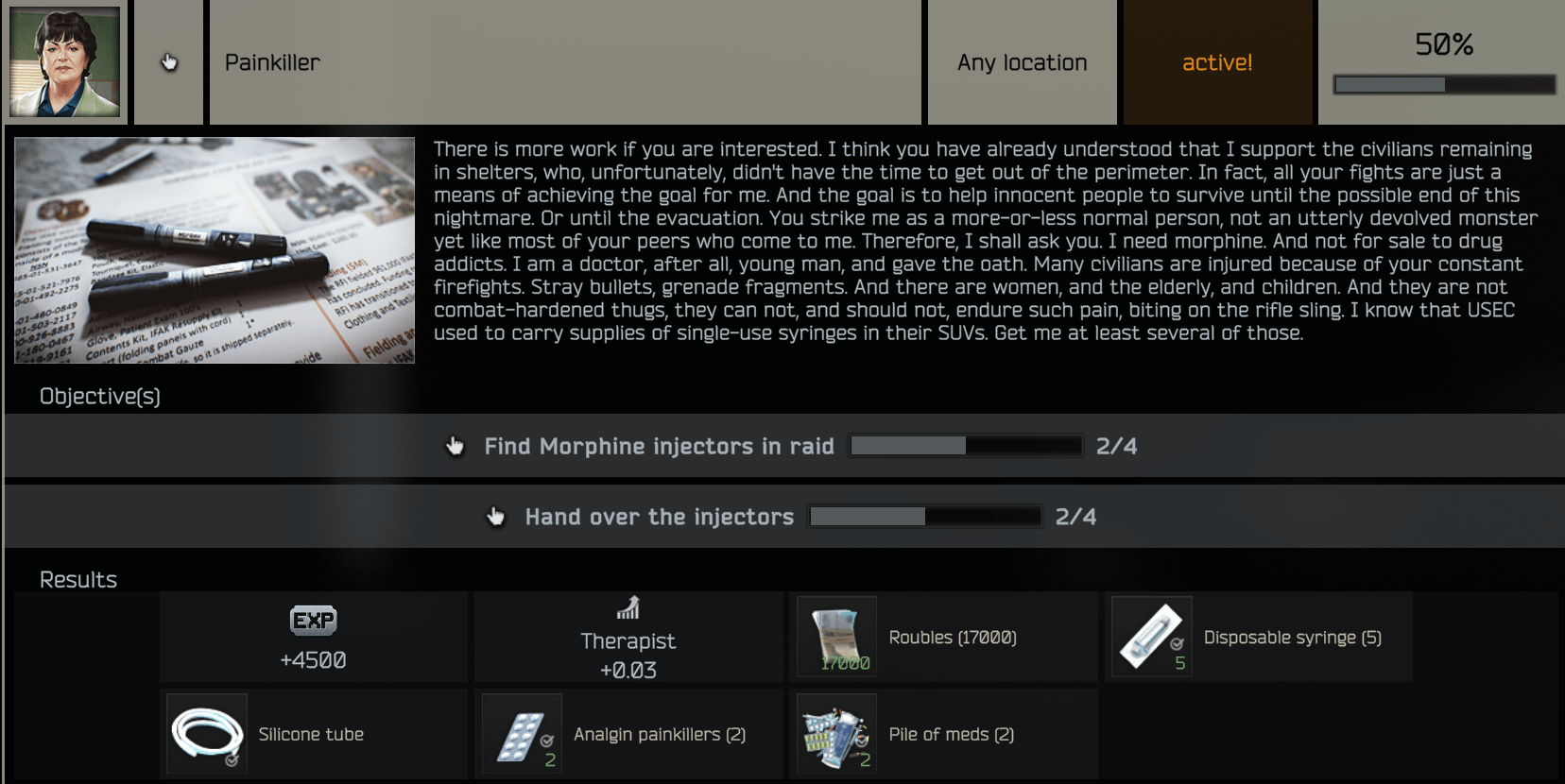
If you’re not questing in Escape from Tarkov, you’re playing the game on hard mode. And I understand the irony of saying that. Quests are more than just missions — they’re the single most rewarding progression path in the game, especially early- and mid-wipe. They unlock trader loyalty, grant powerful gear, and open up systems you literally can’t access otherwise.
Let’s break down exactly what you get from quests — and why it all matters.
1. Experience Points (EXP) – Fastest Way to Level Up
You can’t really talk about EFT quest rewards and not mention experience points. Most early quests give you between 1,500 to 15,000 EXP, and that scales as the tasks get harder. Completing just a few starter quests can launch you from level 1 to 10 in just a handful of raids.
Here’s how quest EXP compares to other EXP sources:
| Action | EXP Gained (approx) |
| Killing a scav | 200–500 |
| Extracting alive | 300–1,200 |
| Looting a safe | 150–300 |
| FIR quest item turn-in | 1,500–10,000 |
| Quest completion | 1,500–85,000+ (late game) |
The kicker? FIR turn-ins usually give you EXP before the quest even completes. That means you’re getting EXP while doing the prep, and again when you submit. It adds up fast — and it’s the reason players who rush quests always unlock the flea market first (Level 15) and start printing rubles.
2. Trader Reputation – The Hidden Gatekeeper
Every trader has a rep value, usually starting at 0.20 and increasing with quest progress. You need rep — along with player level and spending — to raise a trader’s Loyalty Level (LL), which directly affects what they’ll sell you.
| Prapor Rep Level | Minimum Rep Required |
| LL2 |
0.20 |
| LL3 | 0.35 |
| LL4 | 0.50 |
Each quest gives +0.01 to +0.05 rep typically, with some late-game quests offering more. A few failures or betrayals can reduce rep — especially in cases where you side with one trader over another (Skier vs. Prapor, etc.).
Without rep:
- You can’t buy AP ammo
- You can’t buy top-tier armor
- You’re locked out of some mods, rigs, or high-capacity mags
- You may not even be able to access future quests
You learn pretty early in the game that reputation matters! BLOG20
3. Quest Rewards – Gear, Keys, and Rare Items
Beyond EXP and rep, quests often hand out items that are hard or impossible to get elsewhere. Some of the most useful early- and mid-game gear comes from simple tasks.
Early Game Must-Have Rewards:
| Quest | Reward | Why It Matters |
| Debut (Prapor) | SKS, ammo, meds | Easy start for new PMCs |
| Shortage (Therapist) | Salewas, meds | Meds are hard to get early |
| Delivery from the Past | Secure container upgrade | Massive QoL boost |
| Gunsmith Part 1+ | Weapons, attachments | Saves rubles and barters |
| Golden Swag | Dorms key | Required for future quests |
Mid/Late Game Unique Rewards:
- THICC Items Case / THICC Weapon Case (from Collector/Kappa questlines)
- Intelligence Folder x3 for Sacred Amulet (Lightkeeper)
- Graphics Cards from BTR Driver quests
- Rogue or Zryachiy Support Services
- Access to locked traders or zones (Jaeger, Lightkeeper)
Often, these rewards are one-time only, meaning you won’t see them again outside the flea market (if they’re even allowed there). That makes completing specific quests a priority if you’re going for gear progression or hideout crafting.
4. Unlocks – Services, Hideout Parts & Game Systems
Some quests don’t just give you loot — they unlock features. Entire portions of the game are hidden behind quest milestones.
Examples:
- “Introduction” (Mechanic) – Unlocks Jaeger
- “Colleagues - Part 3” (Therapist) – Access to Lightkeeper
- “Living High is Not a Crime” – Unlocks rare spawn knowledge for high-tier loot
- “Provocation” (Lightkeeper) – Unlocks Rogue Support
- Gunsmith chain – Unlocks multiple hideout upgrades, barters, and trader mods
Even if you’re not hunting loot, just unlocking QoL perks (like reduced prices, access to barters, or late-game flares) is worth the effort.
5. Cosmetic & Flex Rewards
Some questlines offer clothing unlocks, special weapon builds, or unique reputation gains. These aren’t mandatory — but they’re great for flexing your progression or customizing your look.
- Ragman quests unlock new PMC outfits
- Kappa container is the ultimate flex (and QoL reward)
- Ref and Arena quests can give exclusive cross-mode gear or cosmetic variants
- Fence daily tasks sometimes reward karma boosts, which affect your Scav status and Scav case loot
All of this is just to say that ignoring quests isn’t in your best interest, and you’re going to miss a lot and not just in terms of leveling up.
Top 5 Questing Tips for Escape from Tarkov
Quests can feel overwhelming in Escape from Tarkov, especially once your task list starts stacking across multiple maps and traders. To keep your momentum up and avoid wasting time (or your sanity), here are the five most essential tips to quest smarter, not harder.
These are the core habits that experienced players use to fly through the quest grind without burning out.
1. Stack Multiple Quests in the Same Raid
Before loading into a raid, check which active quests can be completed on the same map — then prioritize locations where objectives overlap. If you can kill Scavs for Prapor while looting FIR items for Mechanic and placing a marker for Ragman, you’ve just made one raid do the work of three. Tools like Tarkov.dev or MapGenie can help you spot quest clusters fast.
2. Pre-Loot and Save Key FIR Items
Many quests require rare FIR (Found in Raid) items that can’t be bought from the flea market. Start collecting these early, even before the quest shows up. Keep things like gas analyzers, flash drives, hoses, and car batteries in your stash — especially if they’re FIR. This lets you instantly complete future quests instead of being stuck farming spawns later.
3. Play in a Group
While being a solo player is a viable playstyle and doesn’t let anyone say otherwise, oftentimes, more people in a group equals a more successful raid extraction. Even if you don’t have friends who play, you can use the matchmaking to create a squad or join one before loading into a raid. Of course, no one is safe from griefing players, so just make sure to say hi as soon as you spawn in. This eases the tension a lot.
4. Prioritize Quests That Unlock Traders and Systems
Not all quests are equal. Some unlock major parts of the game — like Jaeger (via “Introduction”), Lightkeeper, or key hideout upgrades. Focus on these first. Unlocking traders early means faster access to better gear, ammo, and barters, which makes all future quests easier.
5. Don’t Sleep on Daily and Weekly Tasks
Operational tasks offer huge value: reliable EXP, gear, trader rep, and rubles — often with simple objectives. Dailies unlock at level 5, weeklies at level 15. Make these part of your routine, especially mid- to late-wipe when mainline quests slow down. If a task doesn’t suit your loadout or map rotation, you can reroll it (for free if you own Edge of Darkness).
Conclusion
Escape from Tarkov doesn’t hand you progression — it makes you fight for it. The quest system is the backbone of that fight. It’s how you level up, unlock better gear, gain the trust of traders, and piece together the brutal story of Tarkov’s collapse. Whether you're trying to reach Kappa or just survive your first Scav run, quests give you structure, rewards, and purpose in a game built on chaos.
You’ve now got the full picture:
- How quests work and why they matter
- Who gives them — from the OG traders to Ref, Lightkeeper, and the BTR Driver
- The types of tasks you'll face and how to prep for them
- The rewards that make questing the most efficient way to progress
- And the smartest tips to help you stay ahead of the grind
The beauty of Tarkov’s quest system is that it doesn’t hold your hand — but it does reward the players who learn how to navigate it. The more you understand how it works, the more you can shape your own path through the wipe, one raid at a time.
So get in there. Check your tasks. Load your markers. And remember — every quest completed is one more step toward mastering Tarkov.
F.A.Q.
How to farm quests fast in EFT?
You can always do multiple quests in the same raid, as long as their objectives are on the same map or use cross-map travel if you’re feeling lucky or are well-prepared.
Are there mandatory quests in Escape from Tarkov?
No quest is technically mandatory, but many unlock traders, the flea market (via leveling), and critical gear — skipping them slows your progression significantly.
What are the best quests to complete in EFT?
The best quests that you should do in the game are:
- Debut (Prapor) – early EXP and unlocks
- Shortage (Therapist) – meds and progress
- Gunsmith series (Mechanic) – free gear and easy EXP
- Delivery from the Past – secure container upgrade
- The Punisher series – great for PMC PvP skill
Can I redo a failed quest in EFT?
Yes, you can redo quests from traders. Carefully read the quest objectives and make sure you pay attention to the details, because often it leads to failure and loss of progress.
How to get Kappa in EFT?
To get the Kappa container you need to:
- Complete almost every questline in the game, including those from Lightkeeper and BTR Driver.
- Collect all required streamer items.
- Reach Level 55 and turn in all required items to Fence via the “Collector” quest.


